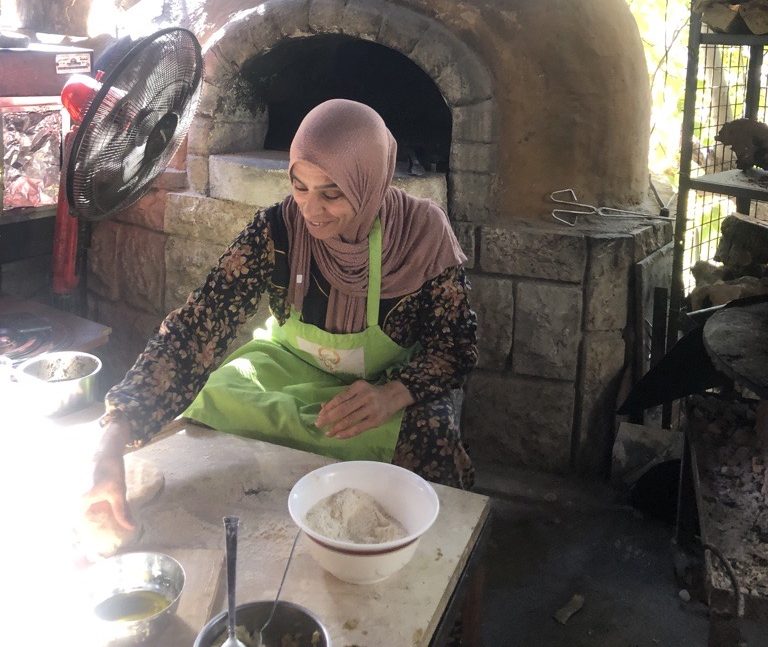Jordan, a country rich in history and culture, offers a variety of flavors that reflect its deep-rooted culinary heritage. Among the many dishes that have stood the test of time, Taboon bread is a staple that has been enjoyed by Jordanians for generations. This flatbread, often served with meals, is an essential part of Jordanian life, especially in rural areas, where it continues to be baked using traditional methods. Let’s explore the art of Taboon bread baking, its cultural significance, and the time-honored techniques that make it so special.
What is Taboon Bread?
Taboon bread is a round, flatbread traditionally baked in a Taboon oven, which is an ancient clay oven used across the Levant region. The bread is made with simple ingredients — flour, water, salt, and yeast — but it’s the method of preparation and cooking that makes it unique. Its texture is soft and chewy on the inside with a slightly crispy crust on the outside, and it is typically enjoyed with a variety of dishes, including olive oil, za’atar, hummus, and grilled meats.

The Traditional Taboon Oven
The key to making authentic Taboon bread lies in the oven itself. The Taboon oven is a large, circular clay structure that is often built in the ground, and its shape ensures that heat is evenly distributed. Traditionally, the firewood or charcoal used to heat the oven gives the bread its distinctive smoky flavor, making it different from bread baked in modern ovens. The oven is preheated to a high temperature, and once it’s ready, the dough is slapped onto the hot clay walls, where it sticks for a few minutes and cooks to perfection.
Baking in the Taboon oven is a social event in many Jordanian households, often involving family members or neighbors gathering around to prepare the bread. The bread is usually baked in batches, and the aroma of freshly baked Taboon fills the air, creating an inviting and warm atmosphere.
The Dough – A Simple Yet Powerful Base
The dough for Taboon bread is made with just a handful of ingredients, yet it is the art of kneading and the patience in letting it rise that elevates the bread to a work of culinary craftsmanship. The dough is kneaded by hand, a process that strengthens the dough and ensures it achieves the right texture.
After kneading, the dough is left to rest and rise, allowing the yeast to work its magic. Once the dough has doubled in size, it is shaped into round, flat discs, ready to be placed into the Taboon oven.
The Social Ritual of Baking Taboon Bread
In many parts of Jordan, especially in rural areas, baking Taboon bread is not just about making food — it’s a community event. Families or neighbors come together, each contributing to the process in their own way. Some knead the dough, others shape it, while others monitor the oven’s temperature. The act of baking Taboon bread is an occasion for socializing, sharing stories, and passing down culinary traditions from one generation to the next.
In Jordanian culture, it’s common to bake Taboon bread in large quantities, ensuring that there is enough to go around for everyone. The bread is often served as a side to accompany a variety of dishes, or it is used as a base for savory spreads and dips.

Taboon Bread in Jordanian Cuisine
Taboon bread has a significant place in Jordanian cuisine. It is versatile and can be eaten with nearly every meal. Whether you’re enjoying a savory dish like mansaf (Jordan’s national dish of lamb and rice) or a lighter meal of hummus, falafel, or baba ganoush, Taboon bread is always there to complement the flavors.
Moreover, the bread is often used as a base for other popular Jordanian snacks. One of these is mana’eesh, a flatbread topped with a mixture of za’atar (a blend of thyme, sesame seeds, and sumac) and olive oil, or even cheese or meat. These snacks are a common breakfast or snack, enjoyed by locals at street-side bakeries or homemade in the kitchen.
The Changing Landscape of Taboon Bread Baking
While the traditional way of baking Taboon bread in a clay oven remains alive in many rural parts of Jordan, the evolution of technology has introduced electric and gas ovens that mimic the effects of the Taboon oven. This has made the process more accessible for people in urban areas who may not have the space or resources for an actual Taboon oven.
However, despite these technological advances, many Jordanians still value the traditional methods. In fact, the demand for homemade Taboon bread has surged in recent years as people rediscover the unique taste and connection to their roots.
Experience Baking Taboon Bread with Zaman Tours
For those who want to experience the process of baking Taboon bread firsthand, Zaman Tours offers a unique opportunity to dive into Jordan’s rich culinary tradition. With a tour through Zaman Tours, you can visit local homes and villages where traditional Taboon bread is still baked in its original clay ovens.
Not only will you learn about the bread’s history and cultural significance, but you’ll also get the chance to roll up your sleeves and take part in the baking process. From kneading the dough to watching the bread bake in the oven, the experience offers a deep connection to Jordanian heritage. It’s a wonderful opportunity to immerse yourself in the social aspect of bread-making, as you’ll be working alongside local families and learning about their time-honored customs.


